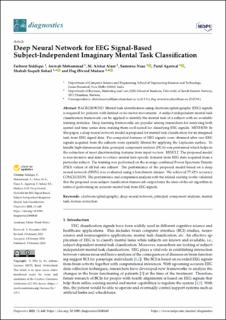| dc.contributor.author | Siddiqui, Farheen | |
| dc.contributor.author | Mohammad, Awwab | |
| dc.contributor.author | Alam, M. Afshar | |
| dc.contributor.author | Naaz, Sameena | |
| dc.contributor.author | Agarwal, Parul | |
| dc.contributor.author | Sohail, Shahab Saquib | |
| dc.contributor.author | Madsen, Dag Øivind | |
| dc.date.accessioned | 2023-06-15T11:13:10Z | |
| dc.date.available | 2023-06-15T11:13:10Z | |
| dc.date.created | 2023-03-21T09:51:51Z | |
| dc.date.issued | 2023 | |
| dc.identifier.citation | Siddiqui, F., Mohammad, A., Alam, M. A., Naaz, S., Agarwal, P., Sohail, S. S. & Madsen, D. Ø. (2023). Deep Neural Network for EEG Signal-Based Subject-Independent Imaginary Mental Task Classification. Diagnostics, 13(4), Artikkel 640. | en_US |
| dc.identifier.issn | 2075-4418 | |
| dc.identifier.uri | https://hdl.handle.net/11250/3071545 | |
| dc.description.abstract | BACKGROUND: Mental task identification using electroencephalography (EEG) signals is required for patients with limited or no motor movements. A subject-independent mental task classification framework can be applied to identify the mental task of a subject with no available training statistics. Deep learning frameworks are popular among researchers for analyzing both spatial and time series data, making them well-suited for classifying EEG signals.
METHOD: In this paper, a deep neural network model is proposed for mental task classification for an imagined task from EEG signal data. Pre-computed features of EEG signals were obtained after raw EEG signals acquired from the subjects were spatially filtered by applying the Laplacian surface. To handle high-dimensional data, principal component analysis (PCA) was performed which helps in the extraction of most discriminating features from input vectors.
RESULT: The proposed model is non-invasive and aims to extract mental task-specific features from EEG data acquired from a particular subject. The training was performed on the average combined Power Spectrum Density (PSD) values of all but one subject. The performance of the proposed model based on a deep neural network (DNN) was evaluated using a benchmark dataset. We achieved 77.62% accuracy.
CONCLUSION: The performance and comparison analysis with the related existing works validated that the proposed cross-subject classification framework outperforms the state-of-the-art algorithm in terms of performing an accurate mental task from EEG signals. | en_US |
| dc.language.iso | eng | en_US |
| dc.rights | Navngivelse 4.0 Internasjonal | * |
| dc.rights.uri | http://creativecommons.org/licenses/by/4.0/deed.no | * |
| dc.title | Deep Neural Network for EEG Signal-Based Subject-Independent Imaginary Mental Task Classification | en_US |
| dc.type | Peer reviewed | en_US |
| dc.type | Journal article | en_US |
| dc.description.version | publishedVersion | en_US |
| dc.rights.holder | © 2023 by the authors. | en_US |
| dc.source.volume | 13 | en_US |
| dc.source.journal | Diagnostics (Basel) | en_US |
| dc.source.issue | 4 | en_US |
| dc.identifier.doi | https://doi.org/10.3390/diagnostics13040640 | |
| dc.identifier.cristin | 2135599 | |
| dc.source.articlenumber | 640 | en_US |
| cristin.ispublished | true | |
| cristin.fulltext | original | |
| cristin.fulltext | original | |
| cristin.qualitycode | 1 | |

